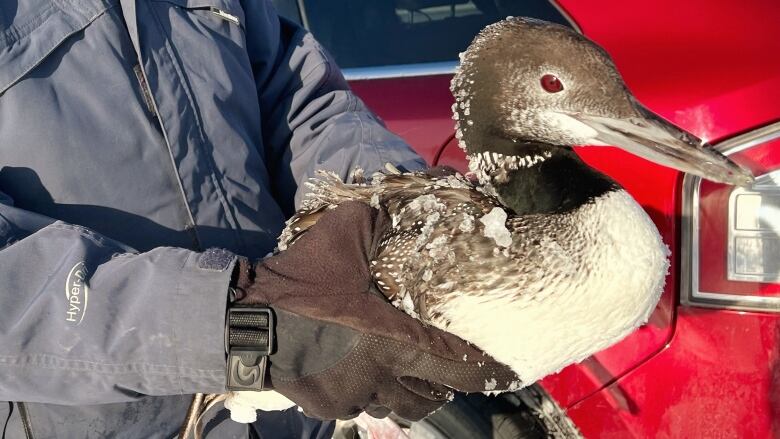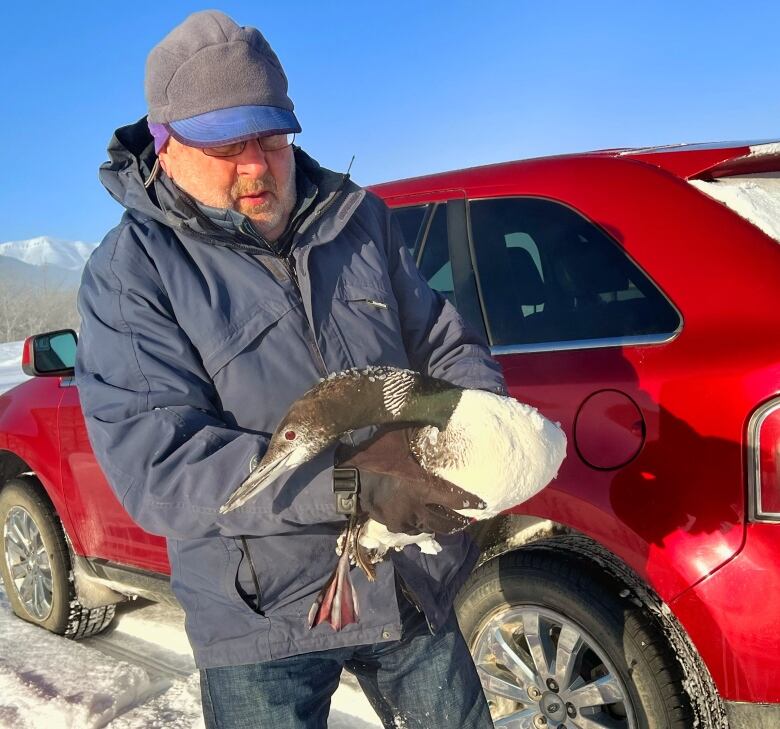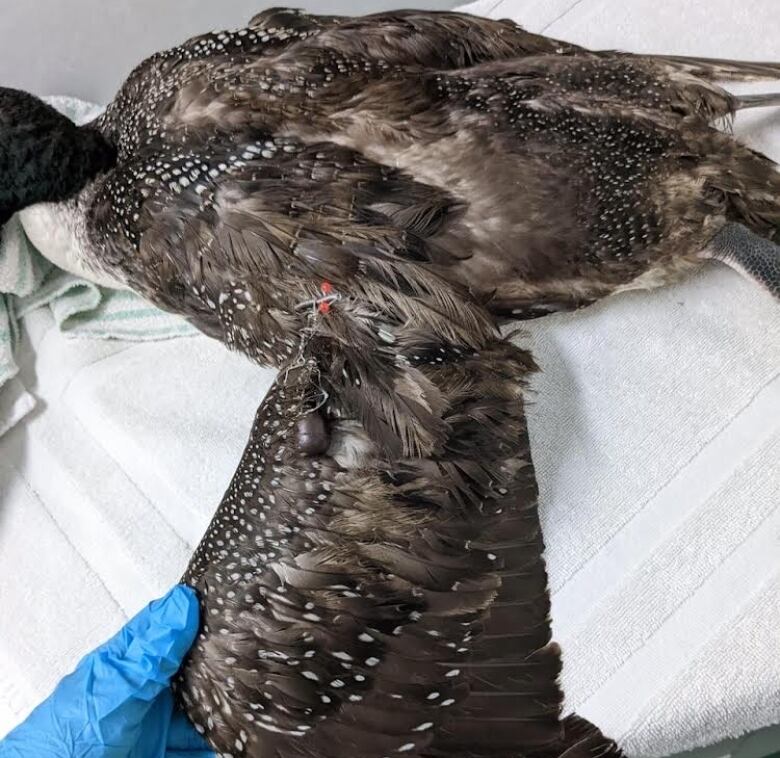Naturalist hopes a loon's fatal fight with fishing gear draws awareness to harms of litter
Fishing line and drink lids identified as most common litter impacting wildlife

David McIntrye says he's still thinking about a loon's cries echoing across Lee Lake, just west of Pincher Creek about 200 kilometres south of Calgary earlier this month.
He says he spotted the loon swimming in a small patch of open water, the frozen lake encroaching around it.
At first, he thought it might've missed its chance to migrate and had become stuck.
"Loons can't take off from, say, a bathtub, they need a long runway to run on the water," said McIntyre, a naturalist and retired study leader with the Smithsonian Institution."So I immediately thought this loon is doomed."
It's uncommon to see loons around his area, McIntyre said, so he felt compelled to help.
He studied the bird for several days, using binoculars from the shore, but when the ice completely froze over and predators started to move in, McIntyre and his wife decided to come up with a rescue plan.Using their knowledge of the lake, they encircled the bird and managed tocaptureit using a jacket and some rafting gear.
That's when they discovered the root of the problem.
"I had the bird in my hands and then I could see the fishing equipment that was embedded in its wing."

The couple brought the bird to a veterinary clinic in Nanton, Alta., where the Alberta Institute for Wildlife Conservation was brought in. Its team discovered fishing wire tightly wrapped around the loon's elbow joint, which caused nerve damage, tissue decay and a spreading infection. It also had a hook embedded in its foot.
The wildlife rescue organization determined the loon's injuries were life-threatening, and it decided to humanely euthanize the bird.
"Unfortunately, there's no way that they would have survived with those injuries," said Holly Lillie, executive director of AIWC. "[It]would never be able to fully extend that wing again and fly properly."
LISTEN | Naturalist Brian Keating explains what happened to the loon on Lee Lake:
AIWCdeals with an average offive animals trapped in fishing gear each year, Lillie says, from loons to geese to seagulls. When including other types of litter entanglements, such as fencing and netting, those numbers jump to 18 last year and 32 in 2020.
Lillie says entanglements are oftena death sentencefor animals.
"And obviously we're unfortunately probably not seeing all of them. You know, I'm sure that many die or get predated upon before they can be rescued," she said.
McIntyre says he was heartbroken to hear about the bird's fate. He's hoping sharing its story will encourage people to be more careful with their fishing gear.
Naturalist Brian Keating, a friend of McIntyre's, spoke about the loononThe Homestretch to raise awareness of the impacts of litter and plastic pollution on wildlife.
"I know accidents happen, and tackle and hooks get lost, but minimizing gear loss, even a seemingly insignificant bit of tackle left in a pond or a lake, it's very important," he said.

Impact of litter on wildlife
The Calgary Wildlife Rehabilitation Society also identified fishing line and drinking lids the round, domed ones with holes in the middle, which end up around animals' necks as the most common litter they see impacting animals.
Director of wildlife care and services, Melanie Whalen, says they see more than 100 animals each year as a result of interactions with litter.
"The numbers are going up slightly yearly as the city expands," she said in an email. "If we incorporate food litter like food waste being left out, that number is much higher."
Throughout her career, Whalen says, she's also seen many diving ducks and loons die from lead poisoning as a result of swallowing lead sinkers or fishing tackle.
Some groups, such as the Alberta Birds of Prey Foundation, near Lethbridge, Alta., and the Cochrane Ecological Institute, reported fewer interactions with fishing line and gear, but see continuing problems with baler twine which ospreys will use in nests barbed wire fencing and abandonedsnares.
Lillie says any litter diverted from the environment will help prevent injuries or fatalities in local wildlife.
"There's so many reasons why we need to keep a clean environment," she said. "It's good for the animals ...and overall health of society, too."
In an email, Alberta Fish and Wildlife Enforcementrecommended those who enjoy recreational fishing to wrap or tie their used fishing line in a small ball and dispose of it in the garbage.
The agency said the public should never risk their own safety to rescue wildlife. It recommends contacting local wildlife rehabilitation groups for help.
For more fascinating stories about Alberta's wildlife from naturalist Brian Keating,visit his websiteand check out these stories:
With files from Taylor Simmons












_(720p).jpg)


 OFFICIAL HD MUSIC VIDEO.jpg)
.jpg)



























































































